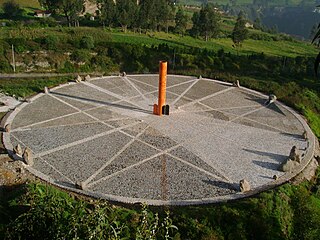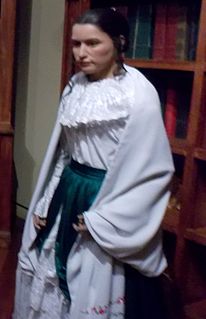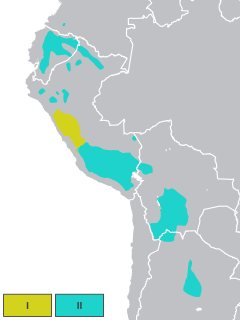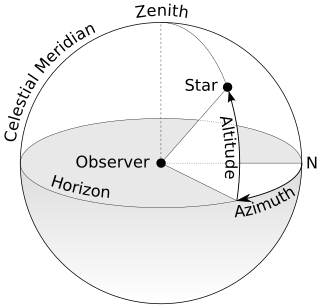The History of Ecuador extends over an 8,000-year period. During this time a variety of cultures and territories influenced what has become the Republic of Ecuador. The history can be divided into five eras: Pre-Columbian, the Conquest, the Colonial Period, the War of Independence, Gran Colombia, and Simón Bolívar the final separation of his vision into what is known today as the Republic of Ecuador.

Quito is the capital and the largest city of Ecuador, and at an elevation of 2,850 metres (9,350 ft) above sea level, it is the second-highest official capital city in the world, after La Paz, and the one which is closest to the equator. It is located in the Guayllabamba river basin, on the eastern slopes of Pichincha, an active stratovolcano in the Andes Mountains. With a population of 2,671,191 according to statistical projections (2019), Quito is the most populous city in Ecuador. It is also the capital of the Pichincha province and the seat of the Metropolitan District of Quito. The canton recorded a population of 2,239,191 residents in the 2010 national census. In 2008, the city was designated as the headquarters of the Union of South American Nations.

The Inca road system was the most extensive and advanced transportation system in pre-Columbian South America. It was about 39,900 kilometres (24,800 mi) long. The construction of the roads required a large expenditure of time and effort. The network was based on two north-south roads with numerous branches. The best known portion of the road system is the Inca Trail to Machu Picchu. Part of the road network was built by cultures that precede the Inca Empire, notably the Wari culture. During the Spanish colonial era, parts of the road system were given the status of Camino Real. In 2014 the road system became a UNESCO World Heritage Site.

Atahualpa, also Atahuallpa, Atabalipa or Atawallpa (Quechua) was the last Inca Emperor. After defeating his brother, Atahualpa became very briefly the last Sapa Inca of the Inca Empire (Tawantinsuyu) before the Spanish conquest.

The Ciudad Mitad del Mundo is a tract of land owned by the prefecture of the province of Pichincha, Ecuador. It is located at San Antonio parish of the canton of Quito, 26 km north of the center of Quito. The grounds contain the Monument to the Equator, which highlights the exact location of the Equator and commemorates the eighteenth century Franco-Spanish Geodesic Mission which fixed its approximate location; they also contain the Museo Etnográfico Mitad del Mundo, Ethnographic Museum Middle of the Earth, a museum about the indigenous people ethnography of Ecuador.

Pambamarca is an eroded stratovolcano in the Central Cordillera of the northern Ecuadorian Andes in Pichincha Province. it is 25 miles (40 km) northeast of Quito. The summit is at an elevation of 4,062 metres (13,327 ft).
The French Geodesic Mission was an 18th-century expedition to what is now Ecuador carried out for the purpose of measuring the roundness of the Earth and measuring the length of a degree of latitude at the Equator. The mission was one of the first geodesic missions carried out under modern scientific principles, and the first major international scientific expedition.
The Cara culture flourished in coastal Ecuador, in what is now Manabí Province, in the first millennium CE.

Pre-Columbian Ecuador included numerous indigenous cultures, who thrived for thousands of years before the ascent of the Incan Empire. Las Vegas culture of coastal Ecuador is one of the oldest cultures in the Americas. The Valdivia culture in the Pacific coast region is a well-known early Ecuadorian culture. Ancient Valdivian artifacts from as early as 3500 BC have been found along the coast north of the Guayas Province in the modern city of Santa Elena.

An equator of a rotating spheroid is its zeroth circle of latitude (parallel). It is the imaginary line on the spheroid's surface, equidistant from its poles, dividing it into northern and southern hemispheres. In other words, it is the intersection of the spheroid's surface with the plane perpendicular to its axis of rotation and midway between its geographical poles.

La Alameda Park is a park in Quito.

The Otavalos are an indigenous people native to the Andean mountains of Imbabura Province in northern Ecuador. The Otavalos also inhabit the city of Otavalo in that province. Commerce and handcrafts are among the principal economic activities of the Otavalos, who enjoy a higher standard of living than most indigenous groups in Ecuador and many mestizos of their area.

The Quitsato Sundial is a cultural-tourist place located at La Mitad Del Mundo, near to Cayambe, 47 km north of Quito. It was built in 2006 and inaugurated in 2007 as an independent, non-profit project in a 24,756 ft² area. Its main goal is to share crucial aspects of the astronomical knowledge of the prehispanic cultures of the region. The expositions are carried out by community members as a self-sustaining project. According to Google Maps, the central pillar is 4 meters south of the true equator.

Cochasquí is the "most extensive and most important complex" of Pre-Columbian and pre-Inca Empire ruins in northern Ecuador. The site lies some 30 kilometres (19 mi) in straight-line distance northeast of Quito in Pedro Moncayo Canton in Pichincha Province at 3,040 metres (9,970 ft) meters above sea level.

The Inca-Caranqui archaeological site is located in the village of Caranqui on the southern outskirts of the city of Ibarra, Ecuador. The ruin is located in a fertile valley at an elevation of 2,299 metres (7,543 ft). The region around Caranqui, extending into the present day country of Colombia, was the northernmost outpost of the Inca Empire and the last to be added to the empire before the Spanish conquest of 1533. The archaeological region is also called the Pais Caranqui.

The Pambamarca Fortress Complex consists of the ruins of a large number of pukaras and other constructions of the Inca Empire. The fortresses were constructed in the late 15th century by the Incas to overcome the opposition of the people of the Cayambe chiefdom to the expansion of the Incas in the Andes highlands of present-day northern Ecuador. The Pambamarca fortreses are located in Cayambe Canton in Pichincha Province about 32 kilometres (20 mi) in a straight-line distance northeast of the city of Quito.

Rumicucho or Pucara de Rumicucho is an archaeological site of the Inca Empire in the parroquia of San Antonio de Pichincha, in Quito Canton, Pichincha Province. Ecuador. Rumicucho is a pucara located 23 kilometres (14 mi) in a straight-line distance north of the city of Quito at an elevation of 2,401 metres (7,877 ft). Rumicucho in the Quechua language means "stone corner", perhaps referring to its strategic location between the territory of the Yumbo people to the east and the chiefdoms of the Pais Caranqui to the north.

María Manuela Dominga de Espejo y Aldaz, known as Manuela of the Holy Cross and Mirror was an Ecuadorian journalist, nurse, feminist, and revolutionary. She was the sister of Eugenio Espejo, with whom she discussed and shared Enlightenment and revolutionary, pro-revolutionary thought and ideas.




















